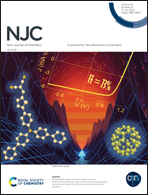Structure–reactivity relationship of probes based on the H2S-mediated reductive cleavage of the C![[double bond, length as m-dash]](https://www.rsc.org/images/entities/char_e001.gif) C bond†
C bond†
Abstract
Recently, we discovered the H2S-mediated reductive cleavage of the C![[double bond, length as m-dash]](https://www.rsc.org/images/entities/char_e001.gif) C bond, and applied this reaction to design probes for the detection of H2S. To extensively elucidate the structure–reactivity relationship, our current work further investigated the effect of substitutes that connected to the C
C bond, and applied this reaction to design probes for the detection of H2S. To extensively elucidate the structure–reactivity relationship, our current work further investigated the effect of substitutes that connected to the C![[double bond, length as m-dash]](https://www.rsc.org/images/entities/char_e001.gif) C bond on the H2S-mediated reductive cleavage, wherein different kinds of electron-withdrawing groups (such as pyridine, bipyridine, terpyridine) and electron donating groups (such as carbazole, N,N-dimethylaniline and phenothiazine) were conjugated to the C
C bond on the H2S-mediated reductive cleavage, wherein different kinds of electron-withdrawing groups (such as pyridine, bipyridine, terpyridine) and electron donating groups (such as carbazole, N,N-dimethylaniline and phenothiazine) were conjugated to the C![[double bond, length as m-dash]](https://www.rsc.org/images/entities/char_e001.gif) C bond of interest. Experimental results and DFT calculations showed that the strength of the electron-donating and withdrawing substitutes could significantly affect the reductive cleavage of the C
C bond of interest. Experimental results and DFT calculations showed that the strength of the electron-donating and withdrawing substitutes could significantly affect the reductive cleavage of the C![[double bond, length as m-dash]](https://www.rsc.org/images/entities/char_e001.gif) C bond. Unexpectedly, the reductive cleavage was not influenced by the change of the C(2) and C(3) positions in phenothiazine. On this basis, two probes (NPTZ-P1 and NPTZ-P2) with a C(3)-substituted phenothiazine were thus developed and successfully applied for sensing exogenous H2S in living HeLa cells, which implied their potential in bioimaging. This study provides further understanding on the structure–reactivity relationship of the H2S-mediated reductive cleavage of the C
C bond. Unexpectedly, the reductive cleavage was not influenced by the change of the C(2) and C(3) positions in phenothiazine. On this basis, two probes (NPTZ-P1 and NPTZ-P2) with a C(3)-substituted phenothiazine were thus developed and successfully applied for sensing exogenous H2S in living HeLa cells, which implied their potential in bioimaging. This study provides further understanding on the structure–reactivity relationship of the H2S-mediated reductive cleavage of the C![[double bond, length as m-dash]](https://www.rsc.org/images/entities/char_e001.gif) C bond, and is also valuable for exploring new reactions of the C
C bond, and is also valuable for exploring new reactions of the C![[double bond, length as m-dash]](https://www.rsc.org/images/entities/char_e001.gif) C bond in organic synthesis.
C bond in organic synthesis.
![Graphical abstract: Structure–reactivity relationship of probes based on the H2S-mediated reductive cleavage of the C [[double bond, length as m-dash]] C bond](/en/Image/Get?imageInfo.ImageType=GA&imageInfo.ImageIdentifier.ManuscriptID=D0NJ02307H&imageInfo.ImageIdentifier.Year=2020)


 Please wait while we load your content...
Please wait while we load your content...
![[double bond, length as m-dash]](https://www.rsc.org/images/entities/h2_char_e001.gif) C bond
C bond